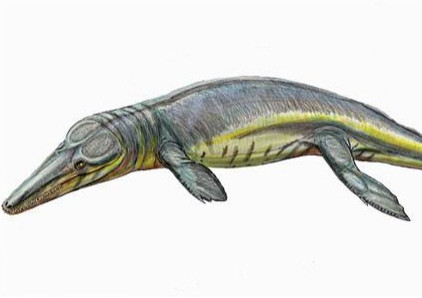'Super-Croc' Fossils From Jurassic Era Unearthed In Scottish Museum Drawer

Most of us are lucky to turn up a few coins when we clean out our junk drawers. Researchers in Scotland scored a much bigger find: the remains of an enormous ancient crocodilian, which they’ve dubbed Tyrannoneustes lythrodectikos, or “blood-biting tyrant swimmer.”
The fossilized remains of the dolphin-like, Jurassic-era predator were originally found by a fossil-hunter named Alfred Leeds between 1907 and 1909. They remained tucked away at the Hunterian Museum and Art Gallery in Glasgow before University of Edinburgh researcher Mark Young and his colleagues found them recently, according to the news service LiveScience. The team described the resurrected find in a paper published earlier in January in the Journal of Systematic Paleontology.
What the scientists can tell from the fossils is that Tyrannoneustes had a jaw at least 26 inches long, a tail fin with a larger bottom -- like an inverted shark’s fin -- and armorless skin. Researchers also think that Tyrannoneustes was specially adapted to eat creatures its own size or larger.
"These features include enlarged teeth, teeth with serrated edges and a change in the shape of the lower jaw that allowed it to open wider," Young told LiveScience on Wednesday.
Tyrannoneustes swam around 165 million years ago in a shallow sea that covers much of what is now Europe, which was also much warmer because it was located farther south.
Modern crocodiles are not descendants of Tyrannoneustes, which belongs to a family of seafaring crocodilians called metriorhynchids. Some of Tyrannoneustes’ close relatives included the genus Geosaurus and the genus Dakosaurus. Many signs of these ancient swimming reptiles have been found in the Oxford Clay Formation, a layer of Jurassic-era sedimentary rock that lies under much of southeast England.
“This new species fills an evolutionary gap in the metriorhynchid fossil record," Young told LiveScience. "The discovery of Tyrannoneustes shows that during the Middle Jurassic, metriorhynchid crocodiles were beginning to evolve into predators of large-bodied prey. By the Late Jurassic, numerous metriorhynchid species were suited to feeding on large prey, but Tyrannoneustes is the first known from the Middle Jurassic. How this impacted upon other predatory groups such as pliosaurs and ichthyosaurs is still unclear."
Still, there’s much that scientists don’t know about these ancient behemoths -- whether they mated and laid eggs on sea or land or whether they even laid eggs at all, instead giving birth to live young like ichthyosaurs, another ancient marine reptile. The evidence may be lost to all time beneath the stratified traces of an ancient sea -- or, perhaps, sitting in a drawer somewhere, waiting to be found.
SOURCE: Young et al. “The oldest known metriorhynchid super-predator: a new genus and species from the Middle Jurassic of England, with implications for serration and mandibular evolution in predacious clades.” Journal of Systematic Palaeontology, published 4 January 2013.
© Copyright IBTimes 2024. All rights reserved.





















